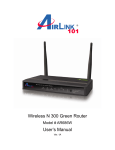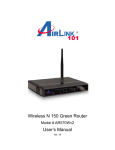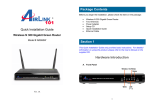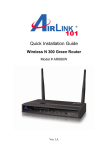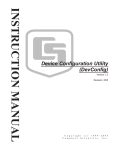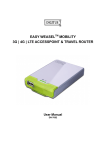Download Airlink101 AR550W3G Network Router User Manual
Transcript
Wireless N 150 3G/3.75G Travel Router Model # AR550W3G User’s Manual Ver. 1A Copyright Copyright © Airlink101, 2010. The contents of this publication may not be reproduced in any part or as a whole, stored, transcribed in an information retrieval system, translated into any language, or transmitted in any form or by any means, mechanical, magnetic, electronic, optical, photocopying, manual, or otherwise, without the prior written permission. Trademarks All products, company, brand names are trademarks or registered trademarks of their respective companies. They are used for identification purpose only. Specifications are subject to be changed without prior notice. FCC Interference Statement This equipment has been tested and found to comply with the limits for a Class B digital device pursuant to Part 15 of the FCC Rules. These limits are designed to provide reasonable protection against radio interference in a commercial environment. This equipment can generate, use and radiate radio frequency energy and, if not installed and used in accordance with the instructions in this manual, may cause harmful interference to radio communications. Operation of this equipment in a residential area is likely to cause interference, in which case the user, at his own expense, will be required to take whatever measures are necessary to correct the interference. CE Declaration of Conformity This equipment complies with the requirements relating to electromagnetic compatibility, EN 55022/A1 Class B. Table of Contents CHAPTER 1 PRODUCT INFORMATION .............................................................................................................1 1.1 INTRODUCTION AND SAFETY INFORMATION .........................................................................................................1 1.2 SAFETY INFORMATION .........................................................................................................................................2 1.3 SYSTEM REQUIREMENTS......................................................................................................................................3 1.4 PACKAGE CONTENTS ...........................................................................................................................................3 1.5 HARDWARE OVERVIEW ........................................................................................................................................4 CHAPTER 2 CONFIGURE THE ROUTER ............................................................................................................6 CHAPTER 3 USING WEB CONFIGURATION UTILITY ..................................................................................16 3.1 WIZARD .............................................................................................................................................................18 3.2 ADVANCED SETTINGS ........................................................................................................................................23 3.2.1 Basic Settings ............................................................................................................................................23 3.2.1.1 Network Setup ...............................................................................................................................24 3.2.1.2 DHCP Server ................................................................................................................................31 3.2.1.3 Wireless .........................................................................................................................................34 3.2.1.4 Change Password .........................................................................................................................41 3.2.2 Security Settings........................................................................................................................................42 3.2.2.1 Packet Filtering ............................................................................................................................42 3.2.2.2 URL Blocking................................................................................................................................45 3.2.2.3 MAC Control.................................................................................................................................46 3.2.2.4 Miscellaneous ...............................................................................................................................48 3.2.3 Advanced Setting.......................................................................................................................................49 3.2.3.1 System Log ....................................................................................................................................50 3.2.3.2 System Time...................................................................................................................................52 3.2.4 Toolbox......................................................................................................................................................53 3.2.4.1 System Info....................................................................................................................................54 3.2.4.2 Firmware Upgrade .......................................................................................................................55 3.2.4.3 Backup Setting ..............................................................................................................................56 3.2.4.4 Reset to Default.............................................................................................................................56 3.2.4.5 Reboot...........................................................................................................................................57 3.2.4.6 Miscellaneous ...............................................................................................................................57 3.3 STATUS ...............................................................................................................................................................58 3.3.1 System Status.............................................................................................................................................59 3.3.2 Wireless Modem Status..............................................................................................................................59 3.3.3 Wireless Status...........................................................................................................................................60 3.3.4 Statistics Information ................................................................................................................................60 CHAPTER 4 TROUBLESHOOTING....................................................................................................................61 APPENDIX A - HARDWARE SPECIFICATION ...................................................................................................63 TECHNICAL SUPPORT........................................................................................................................................64 Chapter 1 Product Information 1.1 Introduction and safety information Thank you for purchasing Airlink101® Wireless N 150 3G/3.75G Travel Router, AR550W3G. This slim and compact travel router assists you to set up a wireless network using your 3G/3.75G USB modem where 3G Internet service is available. When the 3G/3.75G USB modem card is connected to it, all computers and network devices can easily share the 3G mobile Internet connection at high speed. With Wireless N technology, all computers and wireless-enabled network devices (including PDA, cellular phone, game console, and more!) can transfer files up to 150Mbps* (data rate). Stable wireless connection and high bandwidth enable you to enjoy the network applications without any interruption. Other features of this router including: • • • Share Broadband Internet access from your 3G / 3.75G USB modem Wireless data rate of up to 150Mbps* with IEEE 802.11n Supports HSxPA, EVDO, WCDMA Mobile Internet Service • • • • • Reliable wireless connection and higher data rate Advanced NAT+SPI firewall provides full protection for your wireless connection Establish secured wireless connection via Easy Setup Button Built-in USB power interface User-friendly Web-based GUI and EZ Setup Wizard on the Setup CD for quick and simple configuration and management • • Fully backward compatible with 802.11b/g Compact design, great portability for travelers 1 1.2 Safety Information In order to keep the safety of users and your properties, please follow the following safety instructions: 1. This router is designed for indoor use only; DO NOT place this router outdoor. 2. DO NOT put this router at or near hot or humid places, like kitchen or bathroom. Also, do not left this router in the car in summer. 3. If you want to place this router at high places or hang on the wall, please make sure the router is firmly secured. Falling from high places would damage the router and its accessories, and warranty will be void. 4. Accessories of this router, like hood and power supply, are dangerous to small children under 3 years old. They may put the small parts in mouth and it could cause serious danger to them. KEEP THIS ROUTER OUT OF REACH OF CHILDREN! 5. The router will become hot when being used for long time (This is normal and is not a malfunction). DO NOT put this router on paper, cloth, or other flammable materials. 6. There’s no user-serviceable part inside the router. If you found the router is not working properly, please contact your dealer of purchase and ask for help. DO NOT disassemble the router, otherwise warranty will be void. 7. If the router falls into water when it’s powered, DO NOT use your hand to pick it up. Switch the electrical power off before you do anything, or contact an experienced technician for help. 8. Use only power adapter supplied with the product. Use of any other adapters may be dangerous. 2 1.3 System Requirements • • Internet connection provided by 3G/3.75G USB modem Computer with 2.4GHz 802.11 b/g/n wireless network card • Web browser (Microsoft Internet Explorer 5.5 or above, Mozilla Firefox 1.0 or above, or Safari web browser) • An available AC power socket (100 – 240V, 50/60Hz) or two available USB ports on a computer which is powered on 1.4 Package Contents Before starting to use this router, please check if there’s anything missing in the package, and contact your dealer of purchase to claim for missing items: 1. 2. 3. 4. 3G/3.75G Travel Router Power Adapter USB Cable (for power use only) Setup CD 5. Quick Installation Guide 3 1.5 Hardware Overview A. Hardware Configuration Interface Description Power Switch Switch On/Off the Power. Push the button and hold for 1 second to activate WPS procedure. WPS/Reset Push the button and hold for 6 seconds to reset the router to factory default. 4 B. Hood Assembly C. LED Indicators 3G (USB) Wireless LED color Description Blue 3G/3.75G is on Flashing Blue Data access Blue WLAN is on Flashing Blue Data access Quickly Flashing Blue WPS activated 5 Chapter 2 Configure the Router This chapter provides instructions to install and configure the 3G Travel Router. Please follow the steps below to set up the Internet and wireless connection. Step 1 Make sure power switch is switched to OFF. Step 2 Plug your 3G/3.75G USB Modem into the USB port on Router. Step 3 Connect the Power cord to the Router. You can choose either Power Adapter or USB Cable for power supply. A) Use Power Adapter: Connect the provided power adapter to the mini USB power jack and plug the other end into a wall outlet. 6 B) Use USB Cable: Connect the provided USB cable to the mini USB power jack, and plug the other end to 2 USB ports on your PC or Laptop. Note: it’s mandatory to connect both USB connectors at one end of the supplied USB power cable to the computer. Power supply is not sufficient for the device to operate properly if only one USB connector is inserted into the computer. Step 4 Switch on the power of router. 7 Step 5 Connect to the Router from your Laptop/PC by wireless. The default SSID is “Airlink101”. Windows 7 / Vista Users: Click on the wireless icon on the system tray, select ‘Airlink101’ from the available wireless networks, and click on Connect. Windows XP Users: Right click on the wireless icon on the system tray, and go to View Available Wireless Network, select ‘Airlink101’ and click on Connect. 8 Step 6 Insert the Setup CD into your CD-ROM drive. The Autorun screen will pop up. Note: If the autorun screen does not come up properly, go to My Computer Explore the CD Drive go to EZWizard folder, then run EZWizard.exe. You can skip Step 7 and go to Step 8. Windows 7 / Vista Users: When you get warning message(s), make sure that you give permission to run the software. Step 7 Click on EZ Setup Wizard from the menu. 9 Step 8 Select language then click “Next” to continue. Step 9 Click on Wizard. 10 Step 10 Click Next to start the EZ Setup Wizard. Step 11 Configure the SSID (wireless network name, i.e. myHome), Channel, Security mode and Key for this router. It is suggested to select WPA2-PSK for best wireless security. Enter 8~63 characters into Key. Click Next. 11 Step 12 Select the WAN type. If you are connecting your 3G USB modem to the router, please click on 3G. Step 13 Select Auto-Detection and let the wizard detect your 3G modem’s setting automatically or select Manual and enter the 3G settings: Country, Telecom, 3G Network, PIN code, APN, Dialed Number, Username and Password. You can get this information from your 3G Internet Service Provider. Click Next. 12 Step 14 Verify the settings you have configured. Click Next to save the settings and reboot the router. This will take about 30 seconds. Step 15 Reconnect to the router from your wireless computer with the new settings (SSID, security key) that you configured in Step 11. Click Next. 13 Note: Make sure your wireless computer is connected back to the Router with the new SSID and Security Key. Step 16 Click Next to test the Internet Connection, or you can ignore the test; just open the Internet browser and verify if you are connected to the Internet. 14 If you cannot connect to the Internet, please go to 4.2 Troubleshooting. Step 17 Click Finish. Congratulations! Your router configuration has been finished. 15 Chapter 3 Using Web Configuration Utility The Web Configuration Utility contains advanced features that allow you to configure the router to meet your network’s needs such as: Access Control, Security and other functions. If you have already gone through the EZ Setup Wizard, you do NOT need to configure any other thing here for you to start using the Internet. In order to enter the Web Configuration Utility of your router, you need to first log in to the router from your web browser. Please follow the steps below: Step 1 Go to the computer that is wirelessly connected to the router, open the web browser (i.e. Internet Explorer or Mozilla Firefox) and type 192.168.2.1 or the IP address you assigned to this router in the address bar and press Enter. Step 2 Enter the system password and click Login. (The default password is “admin”.) Step 3 When you see the following page coming up, you have successfully logged in to the router. You can now access the complete features/settings of this router. 16 17 3.1 Wizard Select Wizard and click Enter after logging into the router and start the basic configuration. It is also located on the top menu bar. If you have gone through the EZ Setup Wizard on the provided CD, you may skip this section. Click Next to start the Setup Wizard. 18 Step 1 Change System Password. Enter the current password, new password and reconfirm the new password. (The default password is ‘admin’.) If you do not wish to change the password, please leave all fields blank. Click Next. Step 2 Select your Time Zone from the drop down menu and click Next. 19 Step 3 Select 3G for WAN Type if you are accessing the Internet through your 3G USB modem. Select Wi-Fi HotSpot if you want your router to connect to a WiFi network. Keep the LAN IP Address as ‘192.168.2.1’ or assign another one if it is used by other device on your network. Step 4 Select “Auto Detection” for Dial-up Profile, the wizard will try to detect and configure the required 3G service settings automatically. Or you can select “Manual” and manually fill in the required 3G service settings provided by your ISP. Click Next. 20 Step 5 Keep the default SSID (wireless network name) or change it to a desired name, so you can always recognize your local wireless network with it, for example ‘myHome’. Select a channel number for your wireless network. Click Next. Step 6 Set up Wireless Security for your router. It is recommended to select WPA-PSK/WPA2-PSK for Authentication and AES for Encryption, then type in 8~63 characters into Preshare Key. Click Next. WPA2-PSK (AES) is the most secured encryption mode for general users. WEP is the most common encryption but the least secured. It is recommended to use WPA2-PSK (AES) for your wireless security if all wireless devices on your network support it. 21 Note: It is suggested to write down the security settings (Authentication, Encryption and Key) you configured for the Router on a piece of paper and keep it for you to add more wireless device to your network in the future. Step 7 Verify the information you have configured. If everything is correct, click Apply Settings. Wait for 40 seconds while router is restarting. Step 8 Click Finish. Step 9 Reconnect back to router from your wireless computer with the new SSID and security key that you configured in Step 5 and 6. 22 3.2 Advanced Settings Click on Advanced on the top menu bar to enter the advanced settings. 3.2.1 Basic Settings You can configure LAN, Internet connection type, wireless settings and system password for the router here. 23 3.2.1.1 Network Setup You can configure the IP address of your router, and the Internet connection settings. LAN Setup Parameter Description LAN IP Address The local IP address of this router. You can change it if necessary. Subnet Mask Insert 255.255.255.0 for your LAN segment. Internet Setup The Internet Setup section allows you to configure the Internet connection type of your ISP. AR550W3G supports different WAN types of connection for users to connect to remote wireless ISP, such as 3G (WCDMA, HSxPA, HSPA+, CDMA2000, EV-DO, TD-SCDMA), iBurst, and Wi-Fi Hotspot. 3G WAN Type: You may need to manually configure the 3G network settings when your service provider requires you to enter a User Name, Password or other information to connect to the 3G network. 24 Parameter Description Dial-Up Profile Please select Auto-Detection or Manual to continue. You can Select “Auto-Detection”, and the Utility will try to detect and configure the required 3G service settings automatically. Or you can select “Manual” and manually fill in the required 3G service settings provided by your ISP (Internet Service Provide). Country Select your Country. Telecom Select your 3G ISP. 3G Network Select the 3G Network protocol of your 3G USB modem between WCDMA/HSPA and CDMA2000/EV-DO. You can obtain this information from your 3G ISP. APN Enter the APN for your 3G modem here. You can obtain this information from your 3G ISP (Optional) PIN Code Enter the Pin Code for your 3G modem. You can obtain this information from your 3G ISP (Optional) Dial Number This field should not be altered unless it is required by your 3G ISP. 25 Account Enter the new User Name for your 3G modem here, you can obtain this information from your 3G ISP. Password Enter the new Password for your 3G modem here, you can obtain this information from your 3G ISP. Authentication Choose your authentication, you can obtain this information from your 3G ISP. Primary DNS This feature allows you to assign a Primary DNS Server. You can obtain this information from your 3G ISP. Secondary DNS This feature allows you to assign a Secondary DNS Server. You can obtain this information from your 3G ISP. Connection Control There are 3 modes for you to control the 3G connection: Connect-on-demand: Router will connect to the ISP when its clients send outgoing packets. Auto Reconnect (Always-on): Router will keep the connection to the ISP after the connection is established. Manually: Router will not connect to the ISP until user clicks the Connect button on the Status-page. Keep Alive Some 3G Internet Service Providers may disconnect Internet connection if a user is idle (no Internet activity) for certain period of time. Select LCP Echo Request or Ping Remote Host (depends on your ISP) and configure its settings so that Router will send out packets regularly to keep your connection alive. If it is not applicable to your ISP, you can select Disable. 26 iBurst WAN Type: The information on this page will only be used when your service provider requires an account and Password to connect to the iBurst network. Parameter Description Account Enter the User Name for your USB modem here. You can obtain this information from your ISP. Password Enter the password for your USB modem here. You can obtain this information from your ISP. Primary DNS This feature allows you to assign a Primary DNS Server. You can obtain this information from your ISP. Secondary DNS This feature allows you to assign a Secondary DNS Server. You can obtain this information from your ISP. Connection Control There are 3 modes for you to control the 3G connection: Connect-on-demand: Router will connect to the ISP when its clients send outgoing packets. Auto Reconnect (Always-on): Router will keep the connection to the ISP after the connection is established. Manually: Router will not connect to the ISP until user clicks the Connect button on the Status-page. Maximum Idle Time The amount of time of inactivity before disconnecting your PPPoE session. Set it to zero or enable “Auto-reconnect” to disable this feature. 27 Service Name This is optional. Input the service name if your ISP requires it. Otherwise, you can leave it blank. Assign IP Address This is optional. Input the IP address you wish to use. Maximum Transmission Unit (MTU) Most ISP offers MTU value to users. The default MTU value is 0 (auto). NAT Disable Check this box to disable NAT and bridge data from WAN port to LAN port. Click on Save after you finished all settings. You can continue to configure other settings for the router; after you finish, please go to Tools Reboot to reboot the router so the settings will take effect (Please wait for about 35 seconds while router is rebooting). Wi-Fi HotSpot WAN Type: This WAN type allows you to share one Wi-Fi Hotspot account with your friends or colleagues. Just follow a few steps below to connect to a remote Wi-Fi HotSpot. Step 1 Click “Wi-Fi HotSpot” Search” button to search any available Wi-Fi Hotspot or AP (Access Point) in your environment. 28 Step 2 After finish searching, you will see a list of available APs in your environment. You can select the one you wish to connect and click Select, or click Refresh button to search again. Step 3 Enter the Preshare Key of the remote HotSpot you just selected if it is required. Click Save to save the settings. 29 Step 4 Click Reboot button to restart the router and new settings will take effect. 30 3.2.1.2 DHCP Server This page allows you to configure the DHCP settings for your router. Parameter Description DHCP Server Select Disable or Enable the DHCP server. IP Pool Starting/Ending Address Whenever there is a request from a wireless client, the DHCP server will automatically allocate an unused IP address from the IP address pool to the requesting computer. You must specify a range by entering the starting / ending address of the IP address pool. Lease Time DHCP lease time to the DHCP client. Domain Name This is optional, this information will be passed to the client. Press “More…” for more options Primary DNS/Secondary DNS This is optional. This feature allows you to assign a Primary / Secondary DNS Server. 31 Primary WINS/Secondary WINS This is optional. This feature allows you to assign a WINS Server. Gateway This is optional. Gateway address would be the IP address of an alternate Router. Client List Click on Client List to view DHCP clients. Fixed Mapping Click on Fixed Mapping to assign fixed IP address to a specific client according to the client’s MAC address. Please see details below. Fixed Mapping The DHCP Server will reserve the special IP for special MAC address, shows below Parameter Description DHCP Clients Select a DHCP client device from the drop down list. Select an ID from 1 to 10, and click Copy to. The clients MAC address will automatically be filled into the MAC Address table. MAC Address You can manually enter the MAC address of a wireless client. The MAC address format is ‘aa:bb:cc:dd:ee:ff’ IP Address Specify an IP address for the client. 32 Enable Check/Uncheck the Enable box to enable/disable the settings of each mapping rule. Previous / Next You can set up to 100 fixed mapping rules for this router. Click Previous or Next to reach the previous or next 10 entries. Click Save to save the settings you made. 33 3.2.1.3 Wireless You can set parameters that are used for wireless clients to connect to this router. The parameters include SSID, Channel Number, Encryption etc. Parameters Default Description Transmit Power 100% Select the level of transmit power. The higher transmit power consumes more power but provides better signal strength; the lower transmit power consumes less power but provides lower signal strength. It is suggested to keep 100% under normal condition. Network ID (SSID) Channel Airlink101 This is the name of your wireless network. You can type any alphanumeric characters here, maximum 32 characters. SSID is used to identify your own wireless router from others when there are multiple wireless routers in the same area. It’s recommended to change default SSID value to the one which is meaningful to you, like myhome, office_room1, etc. 11 Please select a channel from the drop down list of ‘Channel Number’ for broadcasting. You can choose any channel number you want to use, except that when you use HotSpot for WAN type, the router must follow the 34 channel of the HotSpot. Wireless Mode B/G/N Mixed Please select wireless mode from one of the following options: B Only: 2.4GHz band, only allows 802.11b wireless network client to connect this router (maximum transfer rate 11Mbps*). G Only: 2.4GHz band, only allows 802.11g wireless network client to connect this router (maximum transfer rate 54Mbps*). N Only: 2.4GHz band, only allows 802.11n wireless network client to connect this router (maximum transfer rate 150Mbps*). B/G Mixed: 2.4GHz band, only allows 802.11b and 802.11g wireless network client to connect this router (maximum transfer rate 11Mbps for 802.11b clients, and maximum 54Mbps for 802.11g clients*). B/G/N Mixed: 2.4GHz band, allows 802.11b, 802.11g, and 802.11n wireless network client to connect this router (maximum transfer rate 11Mbps for 802.11b clients, maximum 54Mbps for 802.11g clients, and maximum 150Mbps for 802.11n clients*). Authentication You can choose Open, Shared, Auto, WPA-PSK, WPA2-PSK, WPA-PSK/WPA2-PSK for encryption mode. The detailed settings will appear after you choose an encryption. Encryption There are different configurations depending on the Authentication you select. Please see below for more details. WPS Setup Please see below for more details. Wireless Client List Please see below for more details. 35 Configuring WEP Encryption Note: IEEE802.11n only supports WPA2 or WPA-PSK AES encryption. If you use WEP as your encryption, wireless data rate will drop to 54Mbps (802.11g standard). Authentication: Select Open, Shared or Auto Encryption: Select WEP WEP Key 1~4: HEX/ASCII: Key Value: Select a WEP Key you wish to use Select HEX or ASCII. You can select ASCII (alphanumeric format) or Hexadecimal (in the “A-F”, “a-f” and “0-9” range) for the key format. You can enter 10 or 26-digit Hex key (a~f and 0~9) if you select HEX, or 5 or 13 alphanumeric characters if you select ASCII. Configuring WPA-PSK / WPA2-PSK Encryption Authentication: Select WPA-PSK, WPA2-PSK or WPA-PSK/WPA2-PSK Encryption: Select either AES or TKIP. It is suggested to select AES if all your wireless computers / devices support this encryption mode. Note: IEEE802.11n only supports AES encryption. If you use TKIP as your encryption, wireless data rate will drop to 54Mbps (802.11g standard). Preshare Key: Enter 8~63 characters as the security key of your wireless network. 36 WPS Setup The AR550W3G Wireless N 150 3G/3.75G Travel Router has a built-in Easy Setup Button (WPS) which allows you to connect your wireless computer with the router easily and safely. Your wireless adapter must support this feature as well. If not, you will need to set up the wireless security manually and you can skip this section. In the instructions below, we are going to use the AWLL5077 Airlink101 Wireless N 150 Mini USB Adapter as an example. Step 1 Go to the computer with Airlink101 Wireless N 150 Mini USB adapter, AWLL5077 connected. Step 2 Push and hold the Easy Setup Button on the Adapter until you see the following window pops up on the computer monitor. Step 3 Within the following 2 minutes, push the WPS Button on the Router and hold for 1 second. 37 Step 4 The Router will now start the handshake with the wireless adapter which will take about 30 seconds. When you see the window similar to the one below, the connection has been established. To configure the WPS settings of the router, click on Wireless on the left menu bar and then click on WPS Setup button. 38 Parameters Description WPS Select Enable or Disable WPS function. AP PIN This is the WPS PIN code of this wireless router. This code is useful when you need to build wireless connection by WPS with other WPS-enabled wireless devices using PIN. Config Mode There are “Registrar” and “Enrollee” modes for the WPS connection. When “Registrar” is enabled, the wireless clients will follow the router’s wireless settings for WPS connection. When “Enrollee” mode is enabled, the router will follow the wireless settings of wireless client for WPS connection. Config Status If the wireless security (encryption) function of this wireless router is properly set, you’ll see “Configured” message here. If wireless security function has not been set, you’ll see “unConfigured”. Config Method Select between Push Button and PIN Code. Push Button: Select Push Button and click ‘Trigger’ to start Push-Button setup procedure. The router will wait for WPS requests from wireless clients for 2 minutes. The “WLAN” LED on the wireless router will be blinking quickly when this wireless router is waiting for incoming WPS request. You need to press the WPS button on the wireless client during this time. 39 PIN Code: Select PIN Code and input the code of the wireless client you wish to connect in the blank next to it, and click ‘Trigger’ button below. The “WLAN” LED on the wireless router will be blinking quickly when this wireless router is trying to establish wireless connection with the client. WPS Status It displays if WPS setup procedure is ongoing. Wireless Client List This table displays the wireless clients that are currently associated to the router. You can click Back to go back to the Wireless page, or click Refresh to refresh the list. 40 3.2.1.4 Change Password You can change the password required to log into the Router’s web configuration utility. The default password is “admin”. It is suggested to change the administrator’s default password as soon as you start to use the Router, and store it in a safe place. The password consists of 0 to 9 alphanumeric characters, and are case sensitive Parameters Description Old Password Enter the current password of the router. New Password Enter the new password. Reconfirm Enter the new password again for verification purposes. Note: If you forget your password, you’ll have to reset the router to the factory default (the default password is ‘admin’) by pushing and holding the Reset button on the side of the router for 6 seconds. When both LEDs are blinking simultaneously, the router has been reset. 41 3.2.2 Security Settings This function allows you to configure some Internet access rules for your local computers based on the IP address, MAC address, URL or keywords. 3.2.2.1 Packet Filtering If you want to restrict users from accessing certain Internet applications/services (e.g. Internet websites, email, FTP etc.) by their IP addresses, you can set up the filtering rules here. Entries in this table are restricted to use certain type of connections from the router. Packet filters can be helpful in securing or restricting your local network. 42 Parameters Description Outbound Packet Filter Check/uncheck Enable to enable/disable the Packet Filtering. Allow / Deny all to pass except those match the following rules Please select “Allow” or “Deny” to decide the behavior of packet filtering table. If you select Allow, all traffic will be allowed except the Source IP addresses listed in filtering table. If you select Deny, all traffic will be denied except the Source IP address listed in filtering table. Source IP Please input the client’s IP address you wish to apply the filtering rule. You can input a single IP address (192.168.2.10) or a range of IP addresses (192.168.2.10-192.168.2.50). Leaving this field blank indicates all IP addresses. Destination IP Please input the Destination IP address (i.e. an FTP site, Email server, etc.) you wish to apply the filtering. You can input a single IP address (192.168.2.10) or a range of IP addresses (192.168.2.10-192.168.2.50). Leaving this field blank means all 43 IP addresses. Port Please input the port number here. You can define a single port (80) or a range of ports (1000-1999). Add prefix "T" or "U" to specify TCP or UDP protocol, for example, T80, U53, U2000-2999. No prefix indicates both TCP and UDP are defined. Leaving this field blank indicates all ports. Enable Check/uncheck Enable to enable/disable each Packet Filtering rule. MAC Level Please see MAC Control at 3.2.2.3. Click on Save after you finished all settings. 44 3.2.2.2 URL Blocking You can block access to certain websites or web contents from local PCs by entering a full URL address or just keywords. This feature can help parents to manage the Internet usage for their children (i.e. Parental Control). Parameter Description URL Blocking Check/Uncheck Enable to enable/disable URL Blocking. URL You can enter the full URL address of a website or any keyword of certain website you want to block. Enable Check/Uncheck Enable to enable/disable each rule individually. Click on Save after you finished all settings. 45 3.2.2.3 MAC Control This function will help you to prevent unauthorized users from connecting to your wireless router. Only those network devices with the MAC addresses you specified here are allowed to access your wireless router. You can use this function with other security measures described in previous section together to enhance the safety of your wireless network. Up to 100 MAC addresses can be added by using this function. Parameters Description MAC Access Control Check this box to enable the MAC filtering function. All settings in this page will take effect only when “Enable” is checked. Association Control Check this box to enable the rule that only the wireless client whose MAC addresses are in the table can associate to the wireless LAN. If a client is denied to associate to the wireless LAN, it means the client can't send or receive any data via this router. Choose "allow" or "deny" to determine if the routers allows 46 or denies wireless association from clients whose MAC addresses are not in the table. DHCP Clients Select a DHCP client from the drop down list. Select an ID number and click Copy To. The client’s MAC address will be copied to the ID you selected; you do not need to enter it manually. MAC Address Input a MAC address in the format ‘aa:bb:cc:dd:ee:ff’. A Check this box to allow wireless clients associating to the wireless network. Previous / Next You can set up to 100 fixed mapping rules for this router. Click Previous or Next to reach the previous or next 10 entries. Click on Save after you finished all settings. 47 3.2.2.4 Miscellaneous Parameters Description Administrator Time-out The system will log out the administrator after no activity for a period of time. You may set the time-out period to zero to disable this feature. Remote Administrator Host: Port This feature enables you to perform administration task from remote host. If this feature is enabled, only the specified IP address can perform remote administration. Setting the specified IP address as 0.0.0.0 indicates any host can connect with this product to perform administration task. You can use subnet mask bits "/nn" notation to specified a group of trusted IP addresses, for example, "10.1.2.0/24". NOTE: When Remote Administration is enabled, port 80 will be opened; you can change to other port number such as 8080. Discard PING from WAN side Check this box to enable Discard PING from WAN side. When you enable this feature, your router will not respond to a “ping” request from any host on the WAN side. DoS Attack Detection Check this box to enable the DoS Attack Detection. Router will block the DoS once it is detected. Denial of Service (DoS) is a common attack measure, by transmitting a great amount of data or request to your Internet IP address and server, the Internet connection will become very slow, and server may stop responding because it is not capable to handle too much traffics. Click on Save after you finished all settings. 48 3.2.3 Advanced Setting This page allows you to set up system log and time settings. 49 3.2.3.1 System Log You can enable this function to log all important system events for your router. This page supports two methods to export system logs to specific destination by means of syslog (UDP) and SMTP (TCP). Parameters Description IP address for syslogd Host IP of destination where system log will be sent to. Check Enable to enable this feature Setting of Email alert Check Enable if you want to enable Email alert (send syslog via Email). SMTP Server: Port Input the SMTP server IP and port, which are connected with ':'. If you do not specify port number, the default value is 25. For example, "mail.abc.com" or "192.168.1.100:25". SMTP Username Input the Email user account for the SMTP server. SMTP Password Input the password of the Email account. Email Addresses Enter the Email addresses of the recipients who will receive these logs. You can assign more than 1 recipient by using ';' or ',' to separate these Email addresses. 50 Email Subject The subject of email alert, this setting is optional. View Log Click View Log to view all system logs. Email Log Now Click Email Log Now to email log to the account you set up now. Click on Save after you finished all settings. 51 3.2.3.2 System Time Specify correct Time Zone for your router is very important. It will reflect to the events in system logs. Parameter Description Time Zone You can select your local time zone here. The router will sync time according to your time zone selection. Auto-Synchronization Check Enable to synchronize system time with the Time Server selected below. Time Server Address Select a time server here. Sync with Time Server Click this button to sync the system time with the desired time server. (The router must be connected to the Internet to be able to sync time.) Sync with my PC Click this button to sync system time with the computer. Click on Save after you finished all settings. 52 3.2.4 Toolbox The Toolbox page allows you to view system logs, upgrade firmware, save/reload configuration settings, reset factory default settings, reboot the router, configure UPnP setting, and perform ping test. 53 3.2.4.1 System Info You can view, download, and clear the system logs stored in the router here. 54 3.2.4.2 Firmware Upgrade To upgrade the firmware for the Router, you need to download the firmware file from www.airlink101.com/support/ and save it to your local hard disk first. You may need to unzip it if it is a .zip file. Click on Browse to select the firmware you just downloaded/unzipped, then click Upgrade to start the upgrade process. (You may have to wait a few minutes for the upgrade to complete). NOTE: Never interrupt the upgrade process by closing the web browser or disconnect your computer from router. If the firmware you uploaded is corrupt, the firmware upgrade will fail, and you may contact Technical Support for help. 55 3.2.4.3 Backup Setting You can save the router’s configuration settings to your local hard disk by clicking on Backup Setting and save it as a .bin file. Once you need to restore the settings, please go to Firmware Upgrade page and load the .bin file you saved. 3.2.4.4 Reset to Default To restore the router settings to factory default, click on Reset to Default, and you will be prompted: Click OK to continue or Cancel to exit. 56 3.2.4.5 Reboot To reboot the router, click on Reboot, and you will be prompted: Click OK to continue or Cancel to exit. 3.2.4.6 Miscellaneous Parameter Description UPnP Setting Check to enable UPnP (Universal Plug and Play) setting. You can view this router from “Network Places” after enabling UPnP. Domain Name or IP Address for Ping Test Enter an domain name (i.e. google.com) or IP address to perform ping test. If you can ping a remote website, it means the Internet is connected. Click on Save after you finished all settings. 57 3.3 Status The Status section allows you to monitor the current status of your router. You can use the Status page to monitor: the Internet connection, Wireless, 3G/3.5G Modem status, and the statistics information of the Router. 58 3.3.1 System Status You can view the status of current Internet connection. 3.3.2 Wireless Modem Status You can view the information of your 3G USB modem. 59 3.3.3 Wireless Status You can view the Wireless LAN status of your router, including SSID (the name of your wireless network), Channel number, and Security. 3.3.4 Statistics Information You can view the statistics information of your router, including inbound and outbound packets. 60 Chapter 4 Troubleshooting If you found the router is working improperly or stop responding to you, before you contact your dealer of purchase for help, please read this troubleshooting first. Some problems can be solved by yourself within very short time. Scenario Solution Router is not responding to me when a. Please check the connection of power cord and make sure it is correctly and firmly inserted to the router. I want to access it by web browser b. If all LEDs on this router are off, please check the status of A/C power adapter, and make sure it’s correctly powered, and the power is switched ON. c. You must use the same IP address section which router uses. d. Are you using MAC or Packet filter? Try to connect the router by another computer and see if it works; if not, please restore your router to factory default settings (pressing ‘Reset’ button and hold it for 6 seconds). e. Set your computer to obtain an IP address automatically (DHCP), and see if your computer can get an IP address. f. If you did a firmware upgrade and this happens, contact your dealer of purchase for help. g. If all above solutions don’t work, contact the Airlink101 Technical Support for help. Can’t get connected to Internet a. Go to ‘Status’ and check Internet connection under System Status. You should see valid addresses assigned to IP address, Subnet Mask, Default Gateway and Domain Name Server, instead of showing ‘0.0.0.0’. b. Please be patient, sometime Internet takes 1~2 minutes to be connected, especially 3G network. c. Check if you can get connected to Internet with your computer directly attached to the USB modem provided by your Internet service provider. d. Check 3G user ID and password you configured for the 61 router again if you use 3G service to access Internet. e. Try to reset the router and try again later. I can’t locate my router by my wireless client a. Are you too far from your router? Try to get closer. b. ‘SSID Broadcast’ set to disable? c. Please remember that you have to input SSID on your wireless client manually, if SSID broadcast is disabled. File download is very slow or breaks a. Try to reset the router and see if it’s better after that. b. Try to know what computers do on your local network. If frequently someone’s transferring big files, other people will feel Internet is slowing down. c. If this never happens before, call you Internet service provider to know if there is any problem with their service. I can’t log onto web a. Password you entered is wrong. management interface: b. Password is case-sensitive. Make sure the ‘Caps Lock’ light is not illuminated. c. Make sure you’re connecting to the right router. d. If you really forget the password, do a hardware reset by pressing the Reset button and holding it for 6 seconds . Router becomes hot a. This is not a malfunction, if you can keep your hand on the router’s case. b. If you smell something wrong or see the smoke coming out from router or A/C power adapter, please disconnect the router and A/C power adapter from utility power (make sure it’s safe before you’re doing this!), and call your dealer of purchase for help. The date and time of all event logs are wrong a. Adjust the system time of router. 62 Appendix A - Hardware Specification Advanced Features Standards • IEEE 802.11b / g / n Frequency Range • 2.4GHz Interface • • 1 PIFA Internal Antenna Wireless WAN Type 3G/3.75G (WCDMA,HSDPA,HSUPA, CDMA2000,EV-DO) • Windows®, Mac®, or Linux® operating system • • Internet Explore 5.5 or above Installed 2.4GHz Wireless b/g/n adapter • 93 x 65 x 17mm (L x W x H) Temperature • Operating: 0ºC to 40ºC • Storage: -10ºC to 70ºC Humidity • Operating:10%~90% non-condensing • Storage: 0% to 95% Non-Condensing Warranty WPA / WPA2-PSK • Up to 150Mbps LEDs • Limited 1-year warranty Certification 3G (USB) • Wireless Output Power • • Firewall Multi-lingual UI: English, Spanish, Chinese, and German • Mini USB DC 5V / 1.2A Dimensions • WEP 64 / 128bit Data rate* • • • Power Adapter • PPPoE (for iBurst) • HotSpot Client Security • MAC Control System Requirement 3G USB adapter slot • Reset / WPS Button • Power Switch On/Off • Mini USB Power Jack Antenna • • • 11n/g: 14dBm 11b: 17dBm 63 FCC, CE Technical Support E-mail: [email protected] Toll Free: Website: 1-888-746-3238 www.airlink101.com * The AR550W3G may not support all 3G/3.75G USB modem, please go to www.airlink101.com to check the compatibility list. *Theoretical maximum wireless signal rate derived from IEEE standard 802.11 specifications. Actual data throughput will vary. Network conditions and environmental factors, including volume of network traffic, building materials and construction, mix of wireless products used, radio frequency interference (e.g., cordless telephones and microwaves) as well as network overhead lower actual data throughput rate. Compatibility with 802.11n devices from other manufactures is not guaranteed. Specifications are subject to change without notice. Photo of product may not reflect actual content. All products and trademarks are the property of their respective owners. Copyright ©2010 Airlink101® 64




































































